@boothsun
2018-03-14T07:49:55.000000Z
字数 15458
阅读 3318
ZK客户端操作
ZK
shell操作
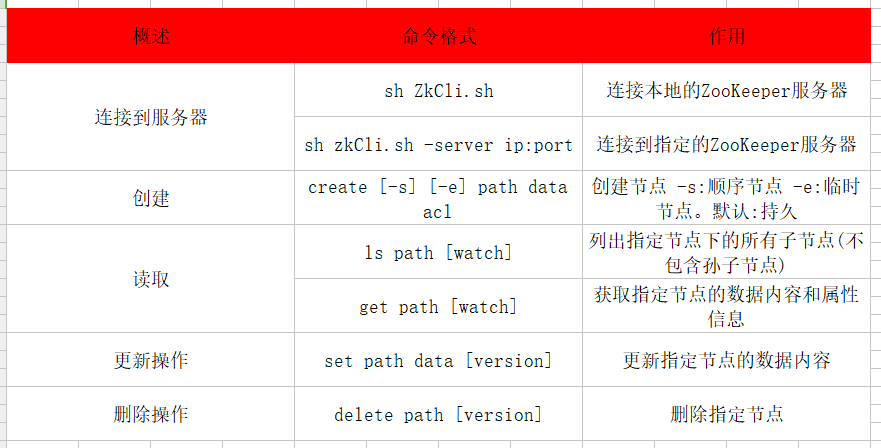
Java客户端
原始API
pom文件:
<dependency><groupId>org.apache.zookeeper</groupId><artifactId>zookeeper</artifactId><version>3.4.10</version></dependency>
Java代码:
public class ZkClientUtil {private static final Logger logger = LoggerFactory.getLogger(ZkDemo.class);private static ZooKeeper zk;// /zfpt 必须提前创建好private static String zkPath = "master:2181,slave1:2181,slave2:2181/zfpt" ;static CountDownLatch connectedSemaphore = new CountDownLatch( 1 );static {try {zk = new ZooKeeper(zkPath, 1000 , new Watcher() {// 监控所有被触发的事件public void process(WatchedEvent event) {logger.info("已经触发了 {} 事件! ", event.getType());connectedSemaphore.countDown();}});}catch (Exception e) {System.err.println("系统异常");}}public static ZooKeeper getZKConnection() {try {if (zk == null) {connectedSemaphore.await();}return zk ;}catch (Exception e) {System.err.printf("ZK初始化失败");}return null ;}}/*** 相应操作*/public class ZkDemoTest {/*** 同步创建 zk节点* @throws Exception*/@Testpublic void create() throws Exception {String response = getZKConnection().create("/aa3","test".getBytes(), ZooDefs.Ids.OPEN_ACL_UNSAFE, CreateMode.PERSISTENT);System.out.println(response) ;}/*** 异步回调创建 zk节点* @throws Exception*/@Testpublic void createASync() throws Exception {CountDownLatch countDownLatch = new CountDownLatch(1) ;//StringCallback 异步回调 ctx:用于传递给回调方法的一个参数。通常是放一个上下文(Context)信息getZKConnection().create("/aa2", "test".getBytes(), ZooDefs.Ids.OPEN_ACL_UNSAFE, CreateMode.EPHEMERAL, (rc, path, ctx, name) -> {System.out.println("rc:" + rc + "&path:" + path + "&ctx:" + ctx + "&name:" + name );countDownLatch.countDown();},"1212121");countDownLatch.await();}/*** 同步删除* @throws Exception*/@Testpublic void delete() throws Exception {// version 表示此次删除针对于的版本号。 传-1 表示不忽略版本号getZKConnection().delete("/aa1",-1);}/*** 异步删除* @throws Exception*/@Testpublic void deleteASync() throws Exception {CountDownLatch countDownLatch = new CountDownLatch(1) ;getZKConnection().delete("/aa1",-1, (rc, path, ctx) -> {System.out.println("rc:" + rc +"&path:" + path + "&ctx:" + ctx);countDownLatch.countDown();},"删除操作");countDownLatch.await();}/*** 同步获取数据,包括子节点列表的获取和当前节点数据的获取* @throws Exception*/@Testpublic void getChildren() throws Exception {Stat stat = new Stat() ;// path:指定数据节点的节点路径, 即API调用的目的是获取该节点的子节点列表// Watcher : 注册的Watcher。一旦在本次获取子节点之后,子节点列表发生变更的话,就会向该Watcher发送通知。Watcher仅会被触发一次。// state: 获取指定数据节点(也就是path参数对应的节点)的状态信息(无节点名和数据内容),传入旧的state将会被来自服务端响应的新state对象替换。List<String> list = ZkClientUtil.getZKConnection().getChildren("/", event -> {System.out.println("我是监听事件,监听子节点变化");} ,stat);System.out.println(list);System.out.println(stat);}/*** 异步获取子节点* @throws Exception*/@Testpublic void getChildrenASync() throws Exception {CountDownLatch countDownLatch = new CountDownLatch(1) ;ZkClientUtil.getZKConnection().getChildren("/",event -> {System.out.println("我是监听事件,监听子节点变化");} , (rc, path, ctx, children) -> {//异步回调System.out.println("children:" + children);countDownLatch.countDown();},"context");countDownLatch.await();}/*** 同步获取数据* @throws Exception*/@Testpublic void getDataTest() throws Exception {Stat stat = new Stat() ;byte[] bytes = ZkClientUtil.getZKConnection().getData("/aa1",event -> {System.out.println("我是监听事件,监听数据状态发生变化");},stat);System.out.println(new String(bytes));}@Testpublic void getDataASync() throws Exception {CountDownLatch countDownLatch = new CountDownLatch(1) ;ZkClientUtil.getZKConnection().getData("/aa1",event -> {System.out.println("我是监听事件,监听数据状态发生变化");}, (rc, path, ctx, data, stat) -> {System.out.println("获取到的内容是:"+new String(data));countDownLatch.countDown();},"121");countDownLatch.await();}/*** 同步更新数据*/@Testpublic void setData() throws Exception{byte[] oldValue = ZkClientUtil.getZKConnection().getData("/aa1",false,null);System.out.println("更新前值是:" + new String(oldValue));Stat stat = ZkClientUtil.getZKConnection().setData("/aa1","helloWorld".getBytes(),-1);byte[] newValue = ZkClientUtil.getZKConnection().getData("/aa1",false,null);System.out.println("更新后值是:" + new String(newValue));}/*** 异步更新数据* @throws Exception*/@Testpublic void setDataASync() throws Exception {CountDownLatch countDownLatch = new CountDownLatch(1) ;ZkClientUtil.getZKConnection().setData("/aa1","helloChina".getBytes(),-1, (rc, path, ctx, name) -> {System.out.println("更新成功");countDownLatch.countDown();},"1111");countDownLatch.await();byte[] newValue = ZkClientUtil.getZKConnection().getData("/aa1",false,null);System.out.println("更新前值是:" + new String(newValue));}}
使用ZkClient客户端
pom.xml
<dependency><groupId>org.apache.zookeeper</groupId><artifactId>zookeeper</artifactId><version>3.4.10</version></dependency><!-- https://mvnrepository.com/artifact/com.101tec/zkclient --><dependency><groupId>com.101tec</groupId><artifactId>zkclient</artifactId><version>0.10</version></dependency>
创建节点:
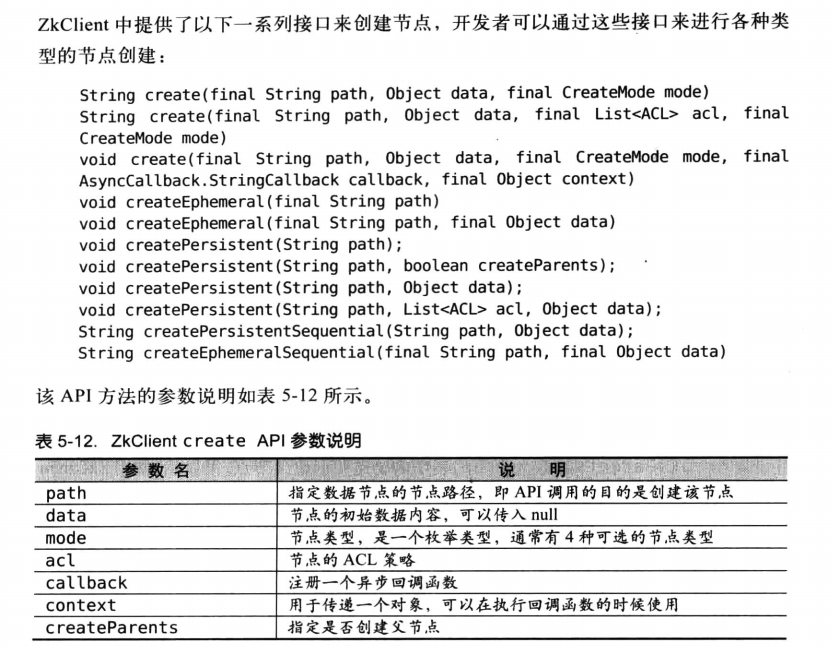
public class ZKClientTest {private static final String zkPath = "master:2181,slave1:2181,slave2:2181/zfpt";private static ZkClient zkClient = null;@Beforepublic void init() {zkClient = new ZkClient(zkPath,10000,10000);}@Testpublic void create() {// 创建节点String result = zkClient.create("/aa3","test", CreateMode.EPHEMERAL);System.out.println(result);// 递归创建zkClient.createPersistent("/trade/open",true);// 注意不要写成这种,API的问题,这种无法递归创建// zkClient.createPersistent("/trade/open",true);}}
相比原始API,ZkClient创建Znode的特性:
- 支持同步创建。
- 更丰富更简单的序列化方式,原始的只能传递byte[]数组。
- 更简便的API,
createPersistent和createEphemeral等。 - 支持递归创建。
删除接口:


@Testpublic void delete() {// 递归删除Boolean results = zkClient.deleteRecursive("/trade");System.out.println("删除结果:" + results);}
特性:
- 递归删除。原始ZooKeeper只支持删除叶子节点。ZkClient支持层级遍历递归删除。
读取子节点:
/*** 获取子节点*/@Testpublic void getChildren() {List<String> childrenList = zkClient.getChildren("/trade");System.out.println(childrenList);}
获取节点数据:
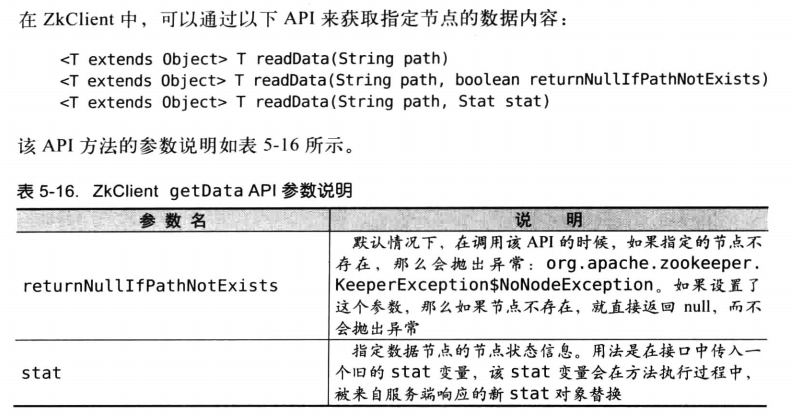
@Testpublic void readData() {String data = zkClient.readData("/trade");System.out.println(data);}
更新数据:
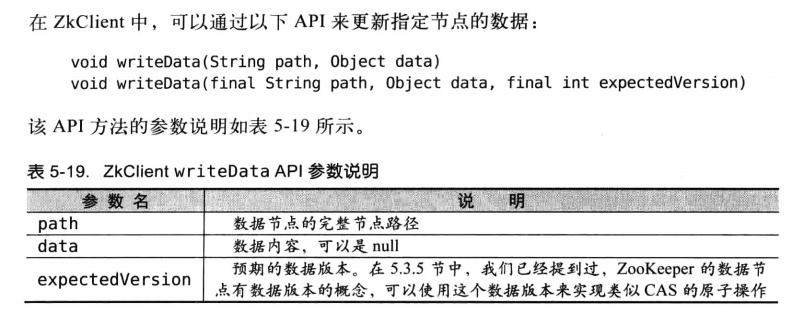
@Testpublic void setData() {String oldValue = zkClient.readData("/trade");System.out.println("获取前:" + oldValue);zkClient.writeData("/trade","I am trade");String newValue = zkClient.readData("/trade");System.out.println("更新后:" + newValue);}
监听器:
//监听子节点变化zkClient.subscribeChildChanges("/trade",(parentPath,currenChilds)->{System.out.println("子节点发生变化");});zkClient.subscribeDataChanges("/trade",new IZkDataListener() {@Overridepublic void handleDataChange(String dataPath, Object data) throws Exception {System.out.println("dataPath:" + dataPath +"发生变化,最新数据是:" + data);}@Overridepublic void handleDataDeleted(String dataPath) throws Exception {System.out.printf("dataPath被删除");}});
原生Watcher只支持一次注册,但是ZkClient的listener已经支持重复注册。
Curator
Curator在ZooKeeper原生API的基础上进行了包装,提供了一套易用性和可读性更强的Fluent风格的客户端API框架。
除此之外,Curator中还提供了ZooKeeper各种应用场景(Recipe 如共享锁服务、Master选举机制和分布式计数器等)的抽象封装。
pom.xml
<dependency><groupId>org.apache.curator</groupId><artifactId>curator-framework</artifactId><version>RELEASE</version></dependency><!-- https://mvnrepository.com/artifact/org.apache.curator/curator-recipes --><dependency><groupId>org.apache.curator</groupId><artifactId>curator-recipes</artifactId><version>RELEASE</version></dependency>
创建节点:
@Beforepublic void before() {// 非Fluent风格// CuratorFramework curatorFramework = CuratorFrameworkFactory.newClient(zkPath, new RetryOneTime(100));// System.out.println(curatorFramework.getState());// curatorFramework.start();// System.out.println(curatorFramework.getState());// Fluent风格curatorFramework = CuratorFrameworkFactory.builder().connectString("master:2181,slave1:2181,slave2:2181").retryPolicy(new RetryOneTime(1000)) //重试策略.namespace("zfpt") // 命名空间.build();curatorFramework.start();}@Testpublic void create() throws Exception {// 创建一个持久化节点,初始化内容为空curatorFramework.create().forPath("/dus");// 创建一个持久化节点,初始化内容不为空curatorFramework.create().forPath("/dus1","test".getBytes());// 创建一个临时节点 初始化内容为空curatorFramework.create().withMode(CreateMode.EPHEMERAL).forPath("/dus2");// 创建一个临时节点,并递归创建不存在的父节点// ZooKeeper中规定所有非叶子节点必须为持久节点。因此下面创建出来只有dus2会是临时节点。curatorFramework.create().creatingParentsIfNeeded().withMode(CreateMode.EPHEMERAL).forPath("/dj/dus2");}
删除节点:
//删除一个节点client.delete().forPath(path);// 删除一个节点,并递归删除其所有子节点client.delete().deletingChildrenIfNeeded().forPath(path)// 删除一个节点,强制指定版本进行删除client.delete().withVersion(version).forPath(path);//删除一个节点,强制保证删除成功client.delete().delete().guaranteed().forPath(path);
guaranteed() 保证删除失败后,Curator会在后台持续进行删除操作。
读取数据:
// 读取一个节点的数据内容client.getData().forPath(path);// 读取一个节点的数据内容,同时获取到该节点的statclient.getData().storingStatIn(stat).forPath(path);
更新数据:
// 更新一个节点的数据内容client.setData().forPath(path);// 更新一个节点的数据内容,强制指定版本进行更新client.setData().withVersion(version).forPath(path);
异步接口:
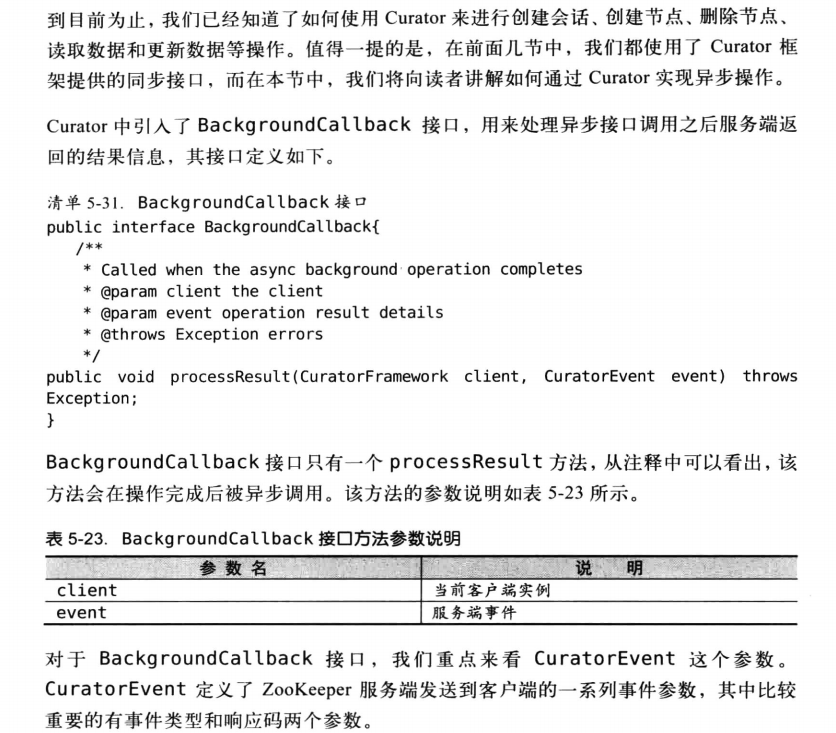
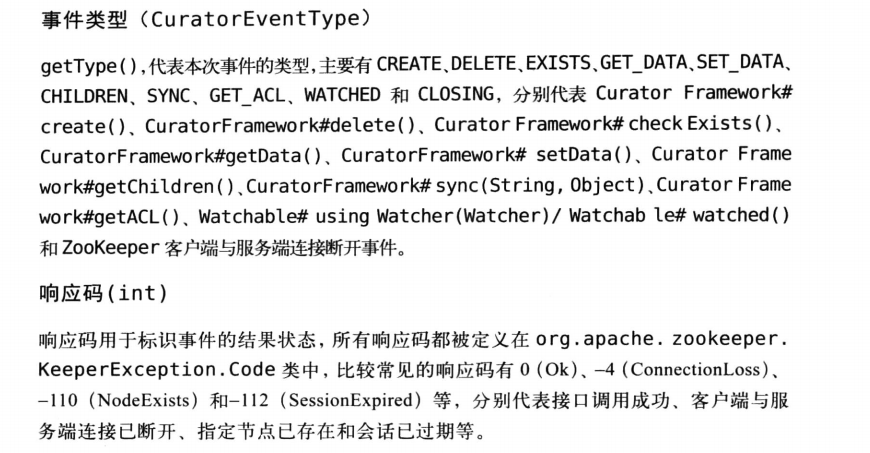
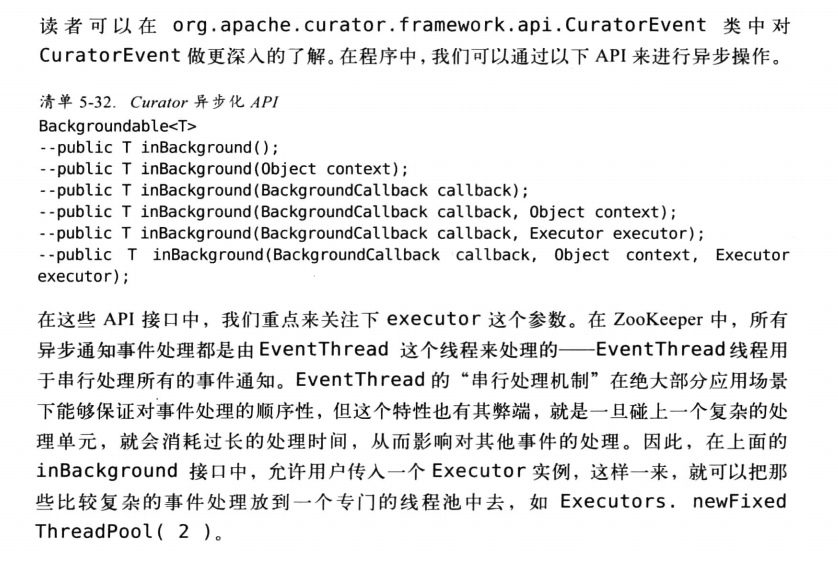
也就是说如果没有传入自定义线程池,就由EventThread这个线程串行处理所有的事件通知,如果传入了,则由自定义线程池去处理。
@Testpublic void BackgroundCallbackTest() throws Exception{CountDownLatch countDownLatch = new CountDownLatch(2);curatorFramework.getData().inBackground((client,event)->{System.out.println(Thread.currentThread().getName());System.out.println(event);System.out.println(client);}).forPath("/trade");Executor executor = Executors.newFixedThreadPool(2,new ThreadFactoryBuilder().setNameFormat("curator-%d").build() );curatorFramework.getData().inBackground((client,event)->{System.out.println(Thread.currentThread().getName());System.out.println(event);System.out.println(client);},executor).forPath("/trade");countDownLatch.await();}
事件监听:
Curator引入了Cache来实现对ZooKeeper服务端事件的监听,Cache是Curator中对事件监听的包装,其对事件的监听其实可以近似看作是一个本地缓存视图和远程ZooKeeper视图的对比过程。同时Curator能够自动为开发人员处理反复注册监听,从而大大简化了原生API开发的繁琐过程。Cache分为两类监听类型:节点监听和子节点监听。
NodeCache:
NodeCache即可以用于监听指定ZooKeeper数据节点内容的变化,也能监听指定节点是否存在,如果原本节点不存在,那么Cache就会在节点被创建后出发NodeCacheListener。但是如果该数据节点被删除,那么Curator就无法再出发NodeCacheListener了。
@Testpublic void NodeCacheTest() throws Exception{// client : Curator 客户端实例 。 path: 监听节点的节点路径 。 dataIsCompressed:是否进行数据压缩NodeCache nodeCache = new NodeCache(curatorFramework,"/trade",false);// buildInitial:如果设置为true 则NodeCache在第一次启动的时候就会立刻从ZK上读取对应节点的数据内容 保存到Cache中。nodeCache.start(false);nodeCache.getListenable().addListener(()->{System.out.println("Node data update , new data:" + new String(nodeCache.getCurrentData().getData()));});//******************** 监听一个不存在的节点 当节点被创建后,也会触发监听器 **********************//// client : Curator 客户端实例 。 path: 监听节点的节点路径 。 dataIsCompressed:是否进行数据压缩NodeCache nodeCache2 = new NodeCache(curatorFramework,"/trade1",false);// buildInitial:如果设置为true 则NodeCache在第一次启动的时候就会立刻从ZK上读取对应节点的数据内容 保存到Cache中。nodeCache2.start(false);nodeCache2.getListenable().addListener(()->{System.out.println("Node data update , new data:" + new String(nodeCache.getCurrentData().getData()));});Thread.sleep(Integer.MAX_VALUE);}
PathChildrenCache:
用于监听指定ZooKeeper数据节点的子节点变化情况。当指定节点的子节点发生变化时,就会回调该方法。PathChildrenCacheEvent类中定义了所有的事件类型,主要包括新增子节点(CHILD_ADDED)、子节点数据变更(CHILD_UPDATED)和子节点删除(CHILD_REMOVED)三类。但是该数据节点的变化不会被此监听器监听到。无法监听孙子节点的变更。
@Testpublic void PathChildrenCacheTest() throws Exception {PathChildrenCache nodeCache = new PathChildrenCache(curatorFramework,"/trade",true);// buildInitial:如果设置为true 则NodeCache在第一次启动的时候就会立刻从ZK上读取对应节点的数据内容 保存到Cache中。nodeCache.start();nodeCache.getListenable().addListener((client , event)->{switch (event.getType()) {case CHILD_ADDED :System.out.println("新增子节点,数据内容是" + new String(event.getData().getData())); break;case CHILD_UPDATED:System.out.println("子节点被更新,数据内容是" + new String(event.getData().getData())); break;case CHILD_REMOVED:System.out.println("删除子节点,数据内容是" + new String(event.getData().getData())); break;default: break;}});curatorFramework.create().withMode(CreateMode.PERSISTENT).forPath("/trade/PathChildrenCache","new".getBytes());Thread.sleep(100L);curatorFramework.setData().forPath("/trade/PathChildrenCache","update".getBytes());Thread.sleep(100L);curatorFramework.delete().withVersion(-1).forPath("/trade/PathChildrenCache");}
Master选举:
在分布式系统中,经常会碰到这样的场景:对于一个复杂的任务,仅需要从集群中选举出一台进行处理即可。诸如此类的分布式问题,我们统称为“Master选举”。借助于ZooKeeper,我们可以比较方便地实现Master选举的功能,其大体思路非常简单:
选择一个根节点,例如/master_select,多台机器同时向该节点创建一个子节点/master_select/lock,利用ZooKeeper的特性,最终只有一台机器能够创建成功,成功的那台机器就作为Master。
Curator也是基于这个思路,但是它将节点创建、事件监听和自动选举过程进行了封装,开发人员只需要调用简单的API即可实现Master选举。
@Testpublic void leaderSelector() throws Exception {AtomicInteger masterCount = new AtomicInteger(0);ExecutorService executor = Executors.newFixedThreadPool(4,new ThreadFactoryBuilder().setNameFormat("master_selector-%d").build() );for( int i = 0 ; i < 4; i++) {executor.execute(()-> {LeaderSelector leaderSelector = new LeaderSelector(curatorFramework, "/master_selector", new LeaderSelectorListenerAdapter() {@Overridepublic void takeLeadership(CuratorFramework curatorFramework) throws Exception {masterCount.incrementAndGet();System.out.println(Thread.currentThread().getName() + "成为Master, 当前Master数量:" + masterCount);Thread.sleep(1000L);System.out.println(Thread.currentThread().getName() + "宕机,失去Master角色,剩下master数量:" + masterCount.decrementAndGet());}});leaderSelector.autoRequeue();leaderSelector.start();});}Thread.sleep(Integer.MAX_VALUE);}
分布式锁:
为了保证数据的一致性,临界资源加锁,保持有序访问。
/*** 观察 Lock【n】 抢到锁 和 Lock【n】 释放锁 是不是成对出现。 如果不是,则说明有重复加锁的* @throws Exception*/@Testpublic void InterProcessMutex() throws Exception {InterProcessMutex lock = new InterProcessMutex(curatorFramework,"/trade/mylock") ;for (int i = 0 ; i < 100 ; i++) {Thread currentThread = new Thread(() -> {try {// 加锁lock.acquire();System.out.println(Thread.currentThread().getName() + " 抢到锁");}catch (Exception e) {} finally {try {System.out.println(Thread.currentThread().getName() + " 释放锁");// 释放锁lock.release();} catch (Exception e) {e.printStackTrace();}}});currentThread.setName("Lock【" + i + "】");currentThread.start();}Thread.sleep(Integer.MAX_VALUE);}
分布式计数器:
@Testpublic void DistributedAtomicInteger() throws Exception {DistributedAtomicInteger distributedAtomicInteger = new DistributedAtomicInteger(curatorFramework,"/trade/PathChildrenCache", new RetryNTimes(1000,3)) ;System.out.println(distributedAtomicInteger.increment().postValue());}
分布式Barrier:
与CyClicBarrir同样的语义。
/*** 没有定义成员数量。直接通过removeBarrier();释放屏障* @throws Exception*/@Testpublic void barrier() throws Exception {ExecutorService executor = Executors.newFixedThreadPool(4,new ThreadFactoryBuilder().setNameFormat("barrier-%d").build() );for( int i = 0 ; i < 4; i++) {executor.execute(()-> {CuratorFramework client = CuratorFrameworkFactory.builder().connectString("master:2181,slave1:2181,slave2:2181").retryPolicy(new RetryOneTime(1000)) //重试策略.namespace("zfpt") // 命名空间.build();client.start();distributedBarrier = new DistributedBarrier(curatorFramework,"/trade/PathChildrenCache") ;System.out.println(Thread.currentThread().getName() + "到达Barrier前");try {distributedBarrier.setBarrier();distributedBarrier.waitOnBarrier();System.out.println(Thread.currentThread().getName() + "越过屏障");} catch (Exception e) {e.printStackTrace();}});}Thread.sleep(3000L);distributedBarrier.removeBarrier();}/*** 定义成员数量,到齐了就 越过屏障* @throws Exception*/@Testpublic void barrier2() throws Exception {ExecutorService executor = Executors.newFixedThreadPool(4,new ThreadFactoryBuilder().setNameFormat("barrier-%d").build() );for( int i = 0 ; i < 4; i++) {executor.execute(()-> {CuratorFramework client = CuratorFrameworkFactory.builder().connectString("master:2181,slave1:2181,slave2:2181").retryPolicy(new RetryOneTime(1000)) //重试策略.namespace("zfpt") // 命名空间.build();client.start();DistributedDoubleBarrier distributedDoubleBarrier = new DistributedDoubleBarrier(client,"/trade/PathChildrenCache",4) ;try {Thread.sleep(1000L);System.out.println(Thread.currentThread().getName() + "到达Barrier前");distributedDoubleBarrier.enter();System.out.println(Thread.currentThread().getName() + "越过屏障");Thread.sleep(1000L);distributedDoubleBarrier.leave();System.out.println(Thread.currentThread().getName() + "已经离开");} catch (Exception e) {e.printStackTrace();}});}Thread.sleep(Integer.MAX_VALUE);}
ZK三种客户端对比
原生API问题
- Zookeeper的Watcher是一次性的,每次触发之后都需要重新进行注册。
- Session超时之后没有实现重试机制。
- 无法实现递归操作(递归创建 递归删除)
- 创建节点时如果节点存在抛出异常,需要自行检查节点是否存在。
- 只提供了简单的byte[]数组的接口,没有提供更丰富的序列化方式(比如对象序列化)。
ZkClient
Zookeeper原生API接口的基础上进行了包装,内部实现了Session超时重连,Watcher反复注册等功能。
- 解决了Session超时重连
- Watcher反复注册等功能。
- 更丰富的序列化方式,ZKClient允许用户自行注册序列化器,然后客户端在进行读写操作过程中,就会自动进行系列化和反序列化操作,默认情况下,ZKClient使用Java自带的序列化方式对对象进行序列化。
Curator 客户端
Curator也解决了很多Zookeeper客户端非常底层的细节开发工作,包括连接重连、Watcher反复注册和NodeExistsException异常。
Curator还在Zookeeper原生API的基础上进行了包装,提供了一套易用性和可读性更强的Fluent风格的客户端API框架。
除此之外,Curator中还提供了Zookeeper各种应用场景(共享锁、Master选择、分布式计数器等)抽象封装。
